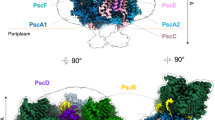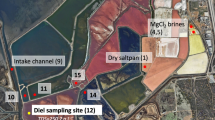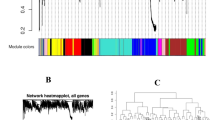Abstract
A natural planktonic bloom of a brown-pigmented photosynthetic green sulfur bacteria (GSB) from the disphotic zone of karstic Lake Banyoles (NE Spain) was studied as a natural enrichment culture from which a nearly complete genome was obtained after metagenomic assembly. We showed in situ a case where horizontal gene transfer (HGT) explained the ecological success of a natural population unveiling ecosystem-specific adaptations. The uncultured brown-pigmented GSB was 99.7% identical in the 16S rRNA gene sequence to its green-pigmented cultured counterpart Chlorobium luteolum DSM 273T. Several differences were detected for ferrous iron acquisition potential, ATP synthesis and gas vesicle formation, although the most striking trait was related to pigment biosynthesis strategy. Chl. luteolum DSM 273T synthesizes bacteriochlorophyll (BChl) c, whereas Chl. luteolum CIII incorporated by HGT a 18-kbp cluster with the genes needed for BChl e and specific carotenoids biosynthesis that provided ecophysiological advantages to successfully colonize the dimly lit waters. We also genomically characterized what we believe to be the first described GSB phage, which based on the metagenomic coverage was likely in an active state of lytic infection. Overall, we observed spread HGT and we unveiled clear evidence for virus-mediated HGT in a natural population of photosynthetic GSB.
Similar content being viewed by others
Log in or create a free account to read this content
Gain free access to this article, as well as selected content from this journal and more on nature.com
or
Accession codes
References
Albertsen M, Hugenholtz P, Skarshewski A, Nielsen K L, Tyson GW, Nielsen PH . (2013). Genome sequences of rare, uncultured bacteria obtained by differential coverage binning of multiple metagenomes. Nat Biotechnol 31: 533–538.
Aminov RI . (2011). Horizontal gene exchange in environmental microbiota. Front Microbiol 2: 158.
Andersson A, Banfield JF . (2008). Virus population dynamics and acquired virus resistance in natural microbial communities. Science 230: 1047–1050.
Andrews SC, Robinson AK, Rodriguez-Quinones F . (2003). Bacterial iron homeostasis. FEMS Microbiol Rev 27: 215–237.
Barberan A, Casamayor EO . (2011). Euxinic freshwater hypolimnia promote bacterial endemicity in continental areas. Microb Ecol 61: 465–472.
Bhaya D, Grossman AR, Steunou AS, Khuri N, Cohan FM, Hamamura N et al. (2007). Population level functional diversity in a microbial community revealed by comparative genomic and metagenomic analyses. ISME J 1: 703–713.
Biller SJ, Berube PM, Lindell D, Chisholm SW . (2015). Prochlorococcus: The structure and function of collective diversity. Nat Rev Microbiol 13: 13–27.
Billington SJ, Huggins AS, Johanesen PA, Crellin PK, Cheung JK, Katz ME et al. (1999). Complete nucleotide sequence of the 27-kilobase virulence related locus (vrl) of Dichelobacter nodosus: evidence for extrachromosomal origin. Infect Immun 67: 1277–1286.
Bryant D, Liu Z, Li T, Zhao F, Costas AG, Klatt C et al. (2012). Comparative and functional genomics of anoxygenic green bacteria from the taxa ChlorobiChloroflexi, and Acidobacteria. In: Burnap R, Vermaas W (eds). Functional Genomics and Evolution of Photosynthetic Systems. Springer: Netherlands, pp 47–102.
Carver T, Harris SR, Berriman M, Parkhill J, McQuillan JA . (2012). Artemis: an integrated platform for visualization and analysis of high-throughput sequence-based experimental data. Bioinformatics 28: 464–469.
Carver T, Thomson N, Bleasby A, Berriman M, Parkhill J . (2009). DNAPlotter: circular and linear interactive genome visualization. Bioinformatics 25: 119–120.
Casamayor EO, Schafer H, Baneras L, Pedros-Alio C, Muyzer G . (2000). Identification of and spatio-temporal differences between microbial assemblages from two neighboring sulfurous lakes: comparison by microscopy and denaturing gradient gel electrophoresis. Appl Environ Microbiol 66: 499–508.
Castresana J . (2000). Selection of conserved blocks from multiple alignments for their use in phylogenetic analysis. Mol Biol Evol 17: 540–552.
Chauhan D, Folea IM, Jolley CC, Kouril R, Lubner CE, Lin S et al. (2011). A novel photosynthetic strategy for adaptation to low-iron aquatic environments. Biochemistry 50: 686–692.
Cohan FM, Koeppel AF . (2008). The origins of ecological diversity in prokaryotes. Curr Biol 18: R1024–U1017.
Cohen PT, Cohen P . (1989). Discovery of a protein phosphatase activity encoded in the genome of bacteriophage lambda. Probable identity with open reading frame 221. Biochem J 260: 931–934.
Deng L, Hayes PK . (2008). Evidence for cyanophages active against bloom-forming freshwater cyanobacteria. Freshwater Biol 53: 1240–1252.
Dupont CL, Rusch DB, Yooseph S, Lombardo MJ, Richter RA, Valas R et al. (2012). Genomic insights to SAR86, an abundant and uncultivated marine bacterial lineage. ISME J 6: 1186–1199.
Edgar RC . (2004). MUSCLE: multiple sequence alignment with high accuracy and high throughput. Nucleic Acids Res 32: 1792–1797.
Figueras JB, Garcia-Gil LJ, Abella CA . (1997). Phylogeny of the genus Chlorobium based on 16S rDNA sequence. FEMS Microbiol Lett 152: 31–36.
Frigaard N-U, Bryant D . (2008). Genomic insights into the sulfur metabolism of phototrophic green sulfur bacteria. In: Hell R, Dahl C, Knaff D, Leustek T (eds). Sulfur Metabolism in Phototrophic Organisms. Springer: Netherlands, pp 337–355.
Frigaard N-U, Bryant DA . (2006). Chlorosomes: antenna organelles in photosynthetic green bacteria. Complex Intracellular Structures in Prokaryotes. Springer: Netherlands, pp 79–114.
Frigaard NU, Bryant DA . (2001). Chromosomal gene inactivation in the green sulfur bacterium Chlorobium tepidum by natural transformation. Appl Environ Microbiol 67: 2538–2544.
Fuhrman JA . (1999). Marine viruses and their biogeochemical and ecological effects. Nature 399: 541–548.
Gordon D, Abajian C, Green P . (1998). Consed: a graphical tool for sequence finishing. Genome Res 8: 195–202.
Grissa I, Vergnaud G, Pourcel C . (2007). CRISPRFinder: a web tool to identify clustered regularly interspaced short palindromic repeats. Nucleic Acids Res 35: W52–W57.
Gregersen LH, Habicht KS, Peduzzi S, Tonolla M, Canfield D E, Miller M et al. (2009). Dominance of a clonal green sulfur bacterial population in a stratified lake. FEMS Microbiol Ecol 70: 30–41.
Guy L, Kultima JR, Andersson SG . (2010). genoPlotR: comparative gene and genome visualization in R. Bioinformatics 26: 2334–2335.
Guindon S, Gascuel O . (2003). A simple, fast, and accurate algorithm to estimate large phylogenies by maximum likelihood. Syst Biol 52: 696–704.
Habicht KS, Miller M, Cox RP, Frigaard NU, Tonolla M, Peduzzi S et al. (2011). Comparative proteomics and activity of a green sulfur bacterium through the water column of Lake Cadagno, Switzerland. Environ Microbiol 13: 203–215.
Han MV, Zmasek CM . (2009). phyloXML: XML for evolutionary biology and comparative genomics. BMC Bioinformatics 10: 356.
Harada J, Mizoguchi T, Satoh S, Tsukatani Y, Yokono M, Noguchi M et al. (2013). Specific gene bciD for C7-Methyl oxidation in bacteriochlorophyll e biosynthesis of brown-colored green sulfur bacteria. PLoS One 8: e60026.
Haring V, Billington SJ, Wright CL, Huggins AS, Katz ME, Rood JI . (1995). Delineation of the virulence-related locus (Vrl) of Dichelobacter nodosus. Microbiology 141: 2081–2089.
Hirabayashi H, Ishii T, Takaichi S, Inoue K, Uehara K . (2004). The role of carotenoids in the photoadaptation of the brown-colored sulfur bacterium Chlorobium phaeobacteroides. Photochem Photobiol 79: 280–285.
Kammler M, Schon C, Hantke K . (1993). Characterization of the ferrous iron uptake system of Escherichia coli. J Bacteriol 175: 6212–6219.
Kim MS, Hong SS, Park K, Myung H . (2013). Genomic analysis of bacteriophage PBECO4 infecting Escherichia coli O157:H7. Arch Virol 158: 2399–2403.
Klatt CG, Wood JM, Rusch DB, Bateson MM, Hamamura N, Heidelberg JF et al. (2011). Community ecology of hot spring cyanobacterial mats: predominant populations and their functional potential. ISME J 5: 1262–1278.
Knaust F, Kube M, Reinhardt R, Rabus R . (2007). Analyses of the vrl gene cluster in Desulfococcus multivorans: homologous to the virulence-associated locus of the ovine footrot pathogen Dichelobacter nodosus strain A198. J Mol Microbiol Biotechnol 13: 156–164.
Lanfear R, Calcott B, Ho SY, Guindon S . (2012). Partitionfinder: combined selection of partitioning schemes and substitution models for phylogenetic analyses. Mol Biol Evol 29: 1695–1701.
Lindell D, Sullivan MB, Johnson ZI, Tolonen AC, Rohwer F, Chisholm SW . (2004). Transfer of photosynthesis genes to and from Prochlorococcus viruses. Proc Natl Acad Sci USA 101: 11013–11018.
Llorens-Mares T, Yooseph S, Goll J, Hoffman J, Vila-Costa M, Borrego CM et al. (2015). Connecting biodiversity and potential functional role in modern euxinic environments by microbial metagenomics. ISME J 9: 1648–1661.
Llorens-Marès T, Triadó-Margarit X, Borrego CM, Dupont CL, Casamayor EO . (2016). High bacterial diversity and phylogenetic novelty in dark euxinic freshwaters analyzed by 16S tag community profiling. Microb Ecol 71: 566–574.
Lohse DL, Denu JM, Dixon JE . (1995). Insights derived from the structures of the Ser/Thr phosphatases calcineurin and protein phosphatase 1. Structure 3: 987–990.
Lorenzi HA, Hoover J, Inman J, Safford T, Murphy S, Kagan L et al. (2011). TheViral Metagenome Annotation Pipeline (VMGAP): an automated tool for the functional annotation of viral Metagenomic shotgun sequencing data. Stand Genomic Sci 4: 418–429.
Luo CW, Tsementzi D, Kyrpides NC, Konstantinidis KT . (2012). Individual genome assembly from complex community short-read metagenomic datasets. ISME J 6: 898–901.
Maresca JA, Graham JE, Bryant DA . (2008a). The biochemical basis for structural diversity in the carotenoids of chlorophototrophic bacteria. Photosynth Res 97: 121–140.
Maresca JA, Romberger SP, Bryant DA . (2008b). Isorenieratene biosynthesis in green sulfur bacteria requires the cooperative actions of two carotenoid cyclases. J Bacteriol 190: 6384–6391.
Martin HG, Ivanova N, Kunin V, Warnecke F, Barry K W, McHardy A C et al. (2006). Metagenomic analysis of two enhanced biological phosphorus removal (EBPR) sludge communities. Nat Biotechnol 24: 1263–1269.
Martiny AC, Huang Y, Li WZ . (2009). Occurrence of phosphate acquisition genes in Prochlorococcus cells from different ocean regions. Environ Microbiol 11: 1340–1347.
Melendrez MC, Lange RK, Cohan FM, Ward DM . (2011). Influence of molecular resolution on sequence-based discovery of ecological diversity among Synechococcus populations in an alkaline siliceous hot spring microbial mat. Appl Environ Microb 77: 1359–1367.
Montesinos E, Guerrero R, Abella C, Esteve I . (1983). Ecology and physiology of the competition for light between Chlorobium limicola and Chlorobium phaeobacteroides in natural habitats. Appl Environ Microbiol 46: 1007–1016.
Nakamura Y, Itoh T, Matsuda H, Gojobori T . (2004). Biased biological functions of horizontally transferred genes in prokaryotic genomes. Nat Genet 36: 760–766.
Oberto J . (2013). SyntTax: a web server linking synteny to prokaryotic taxonomy. BMC Bioinformatics 14: 4.
Ochman H, Lawrence JG, Groisman EA . (2000). Lateral gene transfer and the nature of bacterial innovation. Nature 405: 299–304.
Ohtsubo Y, Ikeda-Ohtsubo W, Nagata Y, Tsuda M . (2008). GenomeMatcher: a graphical user interface for DNA sequence comparison. BMC Bioinformatics 9: 376.
Overmann J, Tuschak C . (1997). Phylogeny and molecular fingerprinting of green sulfur bacteria. Arch Microbiol 167: 302–309.
Palenik B, Ren Q, Tai V, Paulsen IT . (2009). Coastal Synechococcus metagenome reveals major roles for horizontal gene transfer and plasmids in population diversity. Environ Microbiol 11: 349–359.
Polz MF, Alm EJ, Hanage WP . (2013). Horizontal gene transfer and the evolution of bacterial and archaeal population structure. Trends Genet 29: 170–175.
Pruesse E, Peplies J, Glockner FO . (2012). SINA: accurate high throughput multiple sequence alignment of ribosomal RNA genes. Bioinformatics 28: 1823–1829.
R Core Team. (2014). R: A Language and Environment for Statistical Computing. R Foundation for Statistical Computing. Vienna, Austria.
Richter M, Rossello-Mora R . (2009). Shifting the genomic gold standard for the prokaryotic species definition. Proc Natl Acad Sci USA 106: 19126–19131.
Rocap G, Larimer FW, Lamerdin J, Malfatti S, Chain P, Ahlgren NA et al. (2003). Genome divergence in two Prochlorococcus ecotypes reflects oceanic niche differentiation. Nature 424: 1042–1047.
Rohwer F, Thurber RV . (2009). Viruses manipulate the marine environment. Nature 459: 207–212.
Rusch DB, Martiny AC, Dupont CL, Halpern AL, Venter JC . (2010). Characterization of Prochlorococcus clades from iron-depleted oceanic regions. Proc Natl Acad Sci USA 107: 16184–16189.
Saunders NJ, Boonmee P, Peden JF, Jarvis SA . (2005). Inter-species horizontal transfer resulting in core-genome and niche-adaptive variation within Helicobacter pylori. BMC Genomics 6: 9.
Sharon I, Alperovitch A, Rohwer F, Haynes M, Glaser F, Atamna-Ismaeel N et al. (2009). Photosystem I gene cassettes are present in marine virus genomes. Nature 461: 258–262.
Soontharapirakkul K, Promden W, Yamada N, Kageyama H, Incharoensakdi A, Iwamoto-Kihara A et al. (2011). Halotolerant cyanobacterium Aphanothece halophytica contains an Na+-dependent F1F0-ATP synthase with a potential role in salt-stress tolerance. J Biol Chem 286: 10169–10176.
Stamatakis A . (2006). RAxML-VI-HPC: maximum likelihood-based phylogenetic analyses with thousands of taxa and mixed models. Bioinformatics 22: 2688–2690.
Summers AO . (2006). Genetic linkage and horizontal gene transfer, the roots of the antibiotic multi-resistance problem. Anim Biotechnol 17: 125–135.
Tyson GW, Chapman J, Hugenholtz P, Allen EE, Ram RJ, Richardson PM et al. (2004). Community structure and metabolism through reconstruction of microbial genomes from the environment. Nature 428: 37–43.
Van Gemerden H, Mas J . (1995). Ecology of phototrophic sulfur bacteria. In: Blankenship R, Madigan M, Bauer C (eds). Anoxygenic Photosynthetic Bacteria. Springer: Netherlands, pp 49–85.
Villafranca JE, Kissinger CR, Parge HE . (1996). Protein serine/threonine phosphatases. Curr Opin Biotechnol 7: 397–402.
Westra ER, Buckling A, Fineran PC . (2014). CRISPR-Cas systems: beyond adaptive immunity. Nat Rev Microbiol 12: 317–326.
Wiedenbeck J, Cohan FM . (2011). Origins of bacterial diversity through horizontal genetic transfer and adaptation to new ecological niches. FEMS Microbiol Rev 35: 957–976.
Wu XA, Monchy S, Taghavi S, Zhu W, Ramos J, van der Lelie D . (2011). Comparative genomics and functional analysis of niche-specific adaptation in Pseudomonas putida. FEMS Microbiol Rev 35: 299–323.
Zhao Y, Temperton B, Thrash JC, Schwalbach MS, Vergin KL, Landry ZC et al. (2013). Abundant SAR11 viruses in the ocean. Nature 494: 357–360.
Acknowledgements
This research was funded by grant DARKNESS CGL2012-32747 from the Spanish Office of Science (MINECO) to EOC and by the Global Ocean Sampling Project supported by the Beyster Family Foundation Fund of the San Diego Foundation and the Life Technology Foundation (to JCVI). Work on BChl e biosynthesis and the genomics of GSB in the laboratory of DAB was supported by the Division of Chemical Sciences, Geosciences, and Biosciences, Office of Basic Energy Sciences of the U.S. Department of Energy through Grant DE-FG02-94ER20137.
Author information
Authors and Affiliations
Corresponding authors
Ethics declarations
Competing interests
The authors declare no conflict of interest.
Additional information
Supplementary Information accompanies this paper on The ISME Journal website
Supplementary information
Rights and permissions
About this article
Cite this article
Llorens–Marès, T., Liu, Z., Allen, L. et al. Speciation and ecological success in dimly lit waters: horizontal gene transfer in a green sulfur bacteria bloom unveiled by metagenomic assembly. ISME J 11, 201–211 (2017). https://doi.org/10.1038/ismej.2016.93
Received:
Revised:
Accepted:
Published:
Issue date:
DOI: https://doi.org/10.1038/ismej.2016.93
This article is cited by
-
Author Correction: Microbial community dynamics and coexistence in a sulfide-driven phototrophic bloom
Environmental Microbiome (2023)
-
Viruses of sulfur oxidizing phototrophs encode genes for pigment, carbon, and sulfur metabolisms
Communications Earth & Environment (2023)
-
Remarkably coherent population structure for a dominant Antarctic Chlorobium species
Microbiome (2021)
-
Host population diversity as a driver of viral infection cycle in wild populations of green sulfur bacteria with long standing virus-host interactions
The ISME Journal (2021)
-
Influence of the polar light cycle on seasonal dynamics of an Antarctic lake microbial community
Microbiome (2020)



